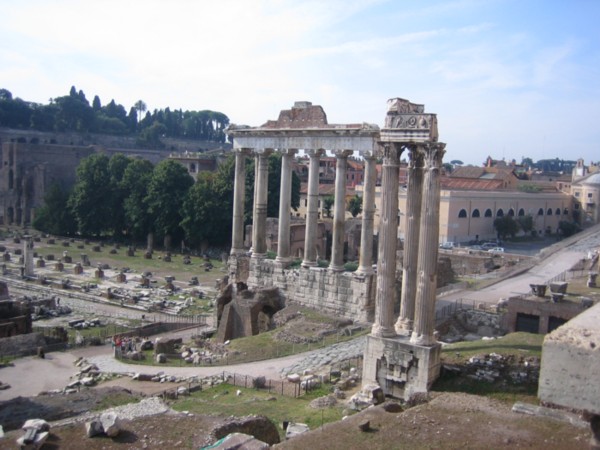|
|
 |
|
melancholy of the ancient world |
|
written
by ninamil7 / 10.24.2005 |
|
|
|
|
|
| melancholy of the antique world |
1 of 1 |
|
| |
Part 1: |
| |
| |

|
|
| Roman Forum |
| This is a view of the "background of immutable ebony" in the Roman Forum as Flaubert describes it. |
| |
|
The bare erected columns and crumbling temples of the Roman Forum do not forcibly inspire awe amongst the contemporary viewer. Yet herein the dusty ruins lies an undeniable force drawing one to come closer and participate in a previous destiny. As you walk over the same stones that once served as streets and look up at the remaining columns of ancient temples, you are able to see Rome through the eyes of its ancient inhabitants. Sitting on a large, dusty block of marble, you can imagine emperors giving speeches to the masses, Vestal virgins guarding the eternal flame, and carriages being pulled over the rocks through the forum. It is through these eyes that one is able to realize the melancholy of the ancient world.
Gazing at the ruins inflicts a feeling of defeat and disappointment. The grand power of ancient Rome proved incapable of standing the test of time, and the ruins in the Roman Forum serve as a reminder of the mortality of such an empire. Once a powerful world force, the center of the Roman Empire remains as no more than a “background of immutable ebony.” The sorrow is not only captured by the ancients who saw their dreams vanish, but also by the contemporary onlookers. As the present viewer realizes the susceptibility to demise that such a great power suffered from, he or she inevitably undergoes some loss of hope for even the greatest powers of today. The melancholy of the ancient world easily transverses time to today’s world as the contemporary viewer stares into the inevitable future of the world as we know it. With this realization comes a dark, hopeless feeling that is hard to shake when standing face to face with the Roman Forum.
|
| |
|
| |
|
| |
Part 2: |
| |
Mount Vesuvius looms as a backdrop to the well-preserved ruins of the ancient city of Pompeii. The destruction of Pompeii was not one of human infliction such as the fall of ancient Rome; rather it was a natural disaster that put an end to the city. The feeling of melancholy protruding from these ruins is not one of defeat or disappointment; rather, it is one of helplessness and inevitability.
The stark ruins of the Roman Forum promote images of emperors, triumphs, and power, while the well-preserved houses, theaters, and forum of Pompeii encourage viewers to see the everyday life of ancient citizens. Colorful marble countertops rest inside local bars where contemporary locals once came to grab some food or possibly a drink; the bathhouse locker-room still has lockers on the wall where sweaty men would have tucked away their belongings. Life in an atrium house comes alive as you walk through old kitchens, living rooms, gardens, and more. Exciting competitions in the stadium and enjoyable plays in the well-preserved theaters once served as entertainment to the local masses. The life in Pompeii is evident down every street that modern day visitors walk through. It’s almost effortless to imagine a time when the streets were lined with houses and storefronts, and shops were full of foods, clothes, furniture, and other goods. In fact, it’s not until you come face to face with a plaster mold of one of the eruption victims that the melancholy of Pompeii comes to light.
In the crumpled body and hollow eyes of an ancient resident of Pompeii, there is an undeniable presence of hopelessness and defeatism. It doesn’t matter how well the city was run or how strong the buildings were made; in the end, the fate of Pompeii was inescapable. The ash of Mount Vesuvius not only buried the buildings and people of Pompeii, but also the hopes, dreams, and future of the city. Today, a new layer of life has been hatched on top of the buried city, leaving only a portion of ancient Pompeii to be excavated and therefore remembered. The stagnant ruins of Pompeii offer glimpses into the everyday ancient life while the plastered bodies serve as a reminder of the sorrow associated with such massive, unavoidable destruction.
|
| |
|
| |
|
|
 |
|

